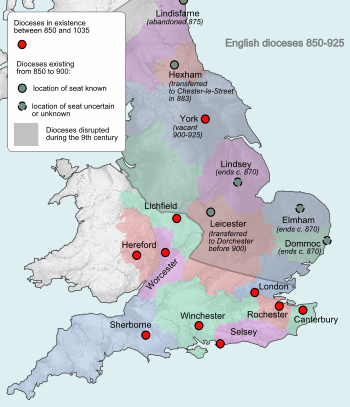Bishop of Lindsey
The Bishop of Lindsey was a prelate who administered an Anglo-Saxon diocese between the 7th and 11th centuries. The episcopal title took its name after the ancient Kingdom of Lindsey.

History
The diocese of Lindsey (Lindine) was established when the large Diocese of Mercia was divided in the late 7th century into the bishoprics of Lichfield and Leicester (for Mercia itself), Worcester (for the Hwicce), Hereford (for the Magonsæte), and Lindsey (for the Lindisfaras).[1]
The bishop's seat at Sidnacester (Syddensis) has been placed, by various commentators, at Caistor, Louth, Horncastle and, most often, at Stow, all in present-day Lincolnshire, England.[2] The location remains unknown.[3] More recently Lincoln has been suggested as a possible site.[2]
After an interruption by the Danish Viking invasions and establishment of the Danelaw in the 9th century, the see of Lindsey was resumed in the mid-10th century until it was united with the bishopric of Dorchester in the early 11th century.
List of bishops
| Bishops of Lindsey | |||
|---|---|---|---|
| From | Until | Incumbent | Notes |
| 678 | c. 679 | Eadhæd | Expelled, and became Bishop of Ripon; also known as Eadhedus, Eadheath or Eadhaed |
| c. 680 | ? 692 | Æthelwine | Possibly died in 692; also known as Ethelwine or Elwin |
| ? 693 | c.716/731 | Edgar | Possibly became bishop in 693; died sometime 716 and 731; also known as Eadgar |
| c.716/731 | 731 | Cyneberht | Became bishop sometime between 716 and 731; also known as Embercus or Kinebertus |
| 733 | 750 | Alwig | Also known as Alwigh |
| 750 | 765 | Ealdwulf | Also known as Aldwulf or Eadulphus |
| c.765/767 | 796 | Ceolwulf | Also known as Ceolulfus |
| 796 | c.836/839 | Eadwulf | Consecrated in 796; died sometime between 836 and 839 |
| c.836/839 | c.862/866 (or later) |
Beorhtred | |
| c.862/866 | c.866/869 | Eadbald | |
| c.866/869 | after 875 | Burgheard or Eadberht | |
| after 875 | before 953 | During this period, the episcopal succession was interrupted by the Danish Viking invasions | |
| before 953 | c.971/975 | Leofwine | Also became Bishop of Dorchester in 971; died between 971 and 975 |
| before 996 | after 1004 | Sigeferth | |
| before 1009 | after 1011 | (? Ælfstan) | Possibly was bishop |
| By the early 11th century, the see of Lindsey had been merged with that of Dorchester | |||
| Source(s): [1][4] | |||
References
- Fryde, E. B.; Greenway, D. E.; Porter, S.; Roy, I. (1986). Handbook of British Chronology (3rd ed.). Cambridge: Cambridge University Press. pp. 218–219. ISBN 0-521-56350-X.
- Paul Jeffery (31 March 2012). England's Other Cathedrals. History Press Limited. p. 45. ISBN 978-0-7524-9035-9.
- Michael Lapidge; John Blair; Simon Keynes; Donald Scragg (2 October 2013). The Wiley Blackwell Encyclopedia of Anglo-Saxon England. John Wiley & Sons. p. 294. ISBN 978-1-118-31609-2.
- Episcopal succession: Lindsey Archived 2008-12-12 at the Wayback Machine. Retrieved on 1 January 2010.